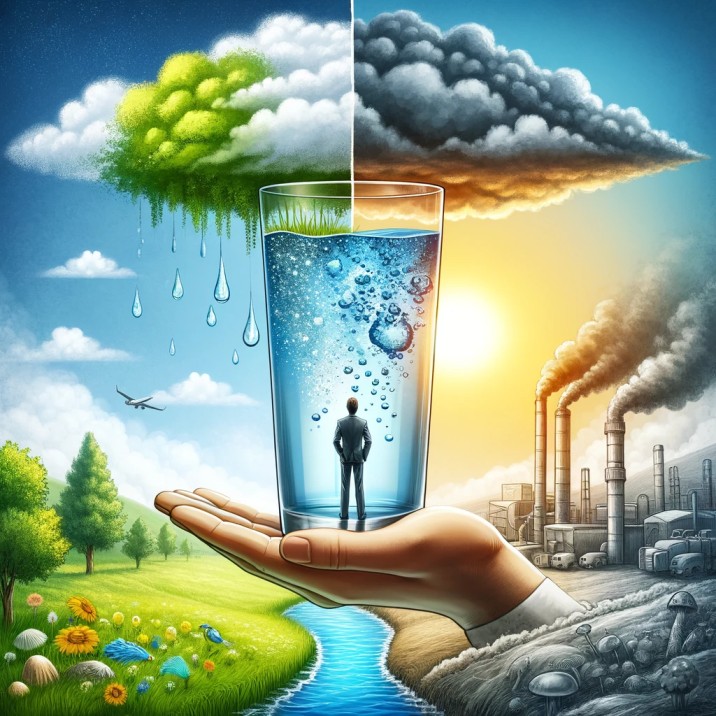Rainwater is not safe to drink directly as it falls due to potential contaminants it can pick up from the atmosphere and surfaces it touches. However, with proper filtration and treatment, it can be made safe for drinking.
Rainwater begins its journey as vapor in the atmosphere and falls to the ground as precipitation. In its purest form, rainwater is relatively clean and theoretically drinkable. However, as it falls through the air and runs off structures, it can pick up contaminants, making it less safe for consumption.

The Journey of Rainwater
When rainwater travels through the atmosphere, it can absorb airborne pollutants, such as dust, pollen, mold spores, and industrial pollutants. This is especially true in urban and industrial areas, where the air quality is often poor. By the time rainwater reaches the ground, it may already contain substances that are not ideal for drinking.
Moreover, as rainwater flows over surfaces like rooftops, it can pick up additional contaminants. These include bird droppings, insects, leaves, and chemicals from roofing materials. In agricultural areas, rainwater may become contaminated with pesticides and fertilizers from farm runoff.
Historical Context and Modern Concerns
Historically, rainwater was a primary water source for many communities, especially in regions where groundwater was scarce or polluted. People collected rainwater in barrels and cisterns for household uses, including drinking. However, with the advent of industrialization and the increase in air and environmental pollution, the purity of rainwater has been significantly compromised.
In modern times, the safety of drinking rainwater largely depends on the level of air pollution and the methods used for collecting and storing the water. In remote and pristine environments, where industrial pollution is minimal, rainwater can be relatively safe to drink after basic filtration and purification.
Collection and Purification
To make rainwater safe for drinking, proper collection and purification methods are essential. Collecting rainwater from clean surfaces and storing it in clean, food-grade containers can help minimize contamination. Using first-flush diverters, which discard the initial rainwater that washes most of the debris off the roof, can also improve the quality of the collected water.
Purification is the next crucial step. Boiling rainwater is one of the simplest and most effective methods to kill pathogens. Filtration systems, ranging from basic cloth filters to more advanced filtration units, can remove larger particulates and contaminants. For complete safety, further treatment methods like UV purification or chemical disinfection (e.g., chlorination) can be employed to ensure the water is free from harmful microorganisms and chemicals.
Health Considerations
When considering the health implications of drinking rainwater, it’s important to understand the potential risks involved and the measures needed to ensure its safety for consumption. Rainwater, in its raw form, can harbor a variety of contaminants that can pose health risks, ranging from mild gastrointestinal issues to more serious illnesses.
One of the primary concerns with untreated rainwater is the presence of pathogens such as bacteria, viruses, and parasites. These microorganisms can originate from bird droppings on rooftops, insects, and other organic matter that the rainwater comes into contact with. Consuming water contaminated with these pathogens can lead to illnesses such as gastroenteritis, characterized by symptoms like nausea, vomiting, diarrhea, and abdominal pain.
Rainwater can also pick up chemical pollutants as it falls through the air, especially in urban or industrial areas. These pollutants can include heavy metals like lead and mercury, as well as chemicals from air pollution like sulfur and nitrogen compounds. Long-term consumption of water contaminated with these substances can lead to various health issues, including neurological problems, kidney damage, and increased risk of certain cancers.
Rainwater is naturally slightly acidic, primarily due to the absorption of carbon dioxide from the atmosphere, forming carbonic acid. While this mild acidity is not typically harmful, rainwater can become more acidic in polluted environments, potentially leading to digestive issues if consumed.
Environmental and Sustainability Aspects
From an environmental perspective, harvesting rainwater can be a sustainable practice. It reduces the reliance on ground or municipal water supplies, which can be beneficial in areas facing water scarcity. Moreover, rainwater harvesting can help in managing stormwater runoff, thereby reducing erosion and pollution in water bodies.
Legal and Regulatory Considerations
In some regions, there are legal and regulatory considerations regarding the collection and use of rainwater. These laws are designed to manage water resources and ensure public health. It’s important for individuals to be aware of and comply with local regulations when collecting and using rainwater.
While rainwater in its purest form is theoretically drinkable, various environmental factors can affect its quality. With appropriate collection, filtration, and purification methods, rainwater can be made safe for drinking, especially in areas with minimal air pollution. However, it is crucial to be aware of the potential risks and take necessary precautions to ensure the safety of rainwater for consumption. As a sustainable resource, rainwater harvesting can be an effective way to supplement water needs, provided it is done responsibly and safely.

